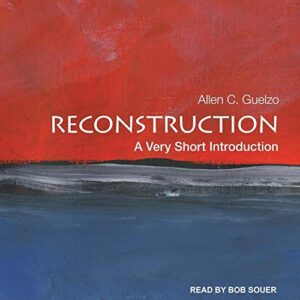 Summary: Fairly standard history of Reconstruction
Summary: Fairly standard history of Reconstruction
I traditionally am a fan of these very short introduction books, but I have read enough of them to know that there is a range in the quality. I have not previously read a book by Allen Guelzo although I have heard good things about some of his books. That being said I do think the author choices in this series matter because there can be some very idiosyncratic approaches to the content.
I do not know if Guelzo was a great choice or not, it is beyond my pay grade, but he has been controversial. He was a very vocal critic of the 1619 Project and participated in a much-maligned American history conference at the White House while Trump was president. Guelzo was invited to participate in the 1776 Project, which was a response to the 1619 Project, but did not. (No historian participated.) Guelzo is also a senior fellow at the controversial Clairmont Institute. Guelzo taught at Eastern University for years, not known for its conservatism, and one of the two reviews on Amazon of the book decries it as “woke history.”
I had a couple of red flags. First, he called out David Blight (insinuated) and Eric Foner (by name) as part of a new movement that distorts the Civil War and reconstruction. I have found both historians very helpful, and they influenced my approach. However, it is not clear to me in this book what exactly he opposes because, in this brief presentation, it seems to mostly agree. The Blight disagreement seems to be mostly in framing.
Foner’s book on reconstruction is fairly dominant at this point. His book on the Reconstruction constitutional amendments was also helpful. The section in this book on the forces of reform within the three main branches of government was helpful because nothing is ever simple. Part of the reality of reconstruction is that it was a fight between the three branches of government about what their post-Civil War roles should be. As Guelzo notes, many brief histories talk about the fight between the executive and legislative branches about who should control reconstruction, but the courts also played a significant role, and essentially, they limited the government’s power, which, by default, hindered reconstitution.
The book summarizes that reconstruction had many goals, but only two were accomplished. First, it reunited the country after the Civil War. Blight contended that the reunification was done at the cost of Black civil rights. Guelzo has a more positive framing and talks about how other civil wars lasted longer and had a more extended post-war history than the US Civil War. He also emphasizes that a second civil war did not break out and that it was a genuine concern that did not happen. And second, the reconstruction amendments changed the understanding of citizenship. The 14th Amendment created a unified understanding of citizenship and equal protection for former slaves, and the 15th established voting rights for African Americans (males).
Mostly, I think this was a reasonably standard reconstruction presentation. It was not an entire failure as it was often presented in the past. And it was not a complete success; the movement into Jim Crow and the role of a culture of white superiority, along with a lack of assistance in moving the formerly enslaved into land ownership and independence, still has implications today.
Republicans did have a problem with corruption, and the weakened Democratic Party meant that the corruption was not dealt with promptly. The courts did limit the legislative ability to legally enact reforms like the 1876 Civil Rights Law, which would have done something to help change the culture.
I picked this up primarily because it was free with my audible membership. Foner’s Second Founding is also free if you have a premium membership on Audible. Both are worth reading.
Reconstruction: A Very Short Introduction by Allen Guelzo Purchase Links: Paperback, Kindle Edition, Audible.com Audiobook